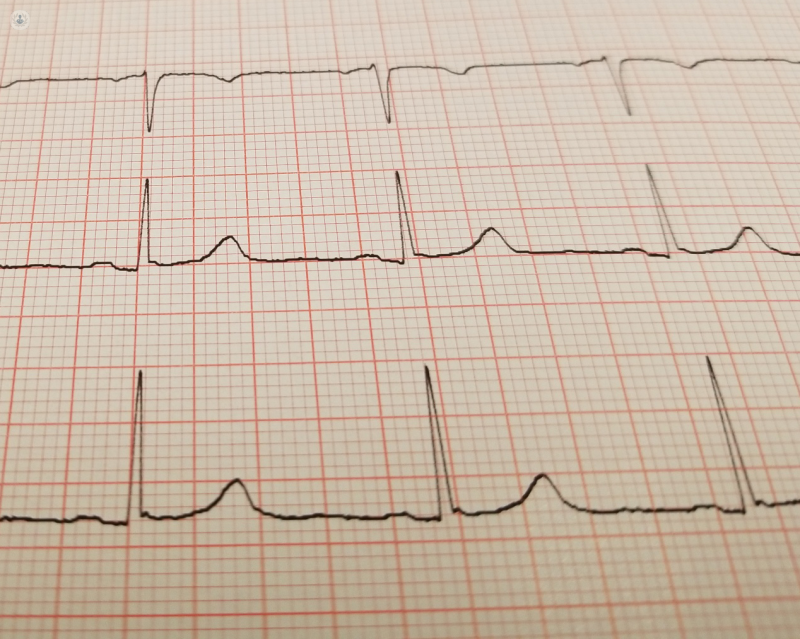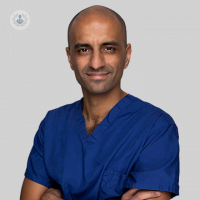Catheter ablation: a solution for atrial fibrillation
Autore:Atrial fibrillation is an abnormal heart rhythm characterised by the rapid and irregular beating of the upper chambers of the heart. Symptoms associated with atrial fibrillation include palpitations, reduction in exercise capacity, difficulty in breathing when exercising, and fatigue. These symptoms can be debilitating and have a significant impact on quality of life.
Available options for treating symptoms of atrial fibrillation include performing a procedure to cure the heart rhythm abnormality, referred to as a catheter ablation procedure, or treatment with medications.

We previously spoke to expert cardiologist and electrophysiologist Dr Saagar Mahida, to find out more about the catheter ablation procedure for atrial fibrillation.
Principles of a catheter ablation procedure
Atrial fibrillation originates in the left upper chamber of the heart, referred to as the left atrium. Atrial fibrillation is commonly triggered by abnormal impulses that originate from four veins that drain blood into the left top chamber of the heart, called the pulmonary veins. In patients with atrial fibrillation, the rhythm abnormality may be continuous (persistent atrial fibrillation) or may be intermittent, with transient episodes occurring with a recurrent pattern (paroxysmal atrial fibrillation). These episodes may last anywhere from a few seconds to a number of hours.
During a catheter ablation procedure, known as a pulmonary vein isolation procedure, the tissue in the region where the pulmonary veins join the heart is modified to create lines of scar in order to block the abnormal impulses that trigger atrial fibrillation. In certain circumstances, the heart rhythm doctor may decide to modify other areas of the upper chambers of the heart in order to treat additional irritable areas of the heart. The ablation procedure involves either using heat (radiofrequency energy) or freezing (cryoballoon) to create the scar.
Success rates and procedural risks of a catheter ablation
Catheter ablation is an effective procedure for treatment of atrial fibrillation, particularly amongst patients with the paroxysmal (intermittent) type of atrial fibrillation. The success rates of a single procedure for paroxysmal atrial fibrillation are between 70-75% and approach 85-90% after more than one procedure.
Amongst patients with continuous atrial fibrillation, the success rates after one procedure are 50%-60%. The success rates approach 70%-80% after more than one procedure. Because the success rates are lower in patients with continuous (persistent) atrial fibrillation, there is an argument for early treatment, before atrial fibrillation progresses from the intermittent (paroxysmal) to continuous (persistent) type.
While complications associated with catheter ablation are rarely seen, they can be significant. The risk of serious complications is generally in the 1 in 100 (1%) range. Your physician will have a detailed discussion with you about the procedure in order to allow you to make an informed decision.
Potential complications include:
- Damage to blood vessels (1-2 in 100 risk)
- Puncture of the heart wall and buildup of fluid in the sac around the heart (1 in 100 risk)
- Blood clots resulting in heart attack or stroke (1 in 200 risk)
- Damage to nerves around heart (1 in 200 risk)
- Narrowing of the pulmonary veins (1 in 200 risk)
- Significant damage to the gullet (1 in 1000 risk)
The procedure from a patient’s perspective
A catheter ablation procedure is performed in a specific environment within a hospital referred to as a cardiac catheterization laboratory. During the procedure, multiple members of a team will be involved, including the heart rhythm specialist doctor (who will perform the procedure), cardiac physiologists and cardiac nurses. The cardiac nurses assist with ensuring that the patient is comfortable and monitor vital signs while the physiologists monitor various technical parameters associated with the procedure. The procedure may be performed with a patient under conscious sedation (awake with medications administered though the vein to help the patient to relax) or under general anaesthesia (in which case an anaesthetist will also be present).
For patients who are having the procedure under conscious sedation, after the sedative has taken effect, local anaesthetic will be injected using a small needle on the top of the leg to numb the puncture site. Once the area is numb, a needle will be used to puncture the vein. A hollow sheath will be introduced into the vein. Long thin tubes, called catheters are inserted into the into the hollow sheath and carefully advanced into the heart. X-ray guidance and/or specialised electrical mapping systems will be used to guide the physician to target specific areas of the heart (where the abnormal impulses originate). The procedure is predicted to last between 2-4 hours. Patients may experience mild discomfort during the ablation procedure. In certain circumstances, artificial hiccups may be induced for a few minutes to monitor function of nerves around the heart.
After the procedure, the catheters and sheaths will be removed and manual pressure will be applied over the puncture site to stop bleeding. Patients are subsequently required to lie flat for a period of four hours to ensure that the bleeding remains controlled. During this period, nursing staff will monitor the puncture site and also vital signs. Anticoagulant (blood thinning medication) and other medications are prescribed by your physician.
Hospital discharge and beyond
The majority of patients are discharged after an overnight stay. In the initial phase after the procedure (up to three months) patients may experience some palpitations, which resolve over time in the majority of cases. Patients may return to work one week after the ablation procedure. However, if a patient’s occupation involves heavy lifting, the physician may recommend increasing the time off work to two weeks.
For more information on catheter ablation and the treatment of heart-related issues, you may wish to book an appointment with a leading cardiologistsuch as Dr Saagar Mahida. Visit his Top Doctors profile for more information.
Publications authored by Dr Mahida’s specifically relating to atrial fibrillation ablation
1. Bartoletti S, Mann M, Gupta A, Khan AM, Sahni A, El-Kadri M, Modi S, Waktare J,
Mahida S, Hall M, Snowdon R, Todd D, Gupta D.
Same-day discharge in selected patients undergoing atrial fibrillation ablation.
Pacing Clin Electrophysiol. 2019 Nov;42(11):1448-1455. doi: 10.1111/pace.13807. Epub
2019 Oct 13.
2. Yamashita S, Tokuda M, Matsuo S, Mahida S, Hachisuka EO, Sato H, Ikewaki H, Oseto H, Yokoyama M, Isogai R, Tokutake K, Yokoyama K, Narui R, Kato M, Tanigawa S, Sugimoto K, Yoshimura M, Yamane T.
J Cardiovasc Electrophysiol. 2019 Nov;30(11):2310-2318. doi: 10.1111/jce.14144.
3. Pearman CM, Redfern J, Williams EA, Snowdon RL, Modi P, Hall MCS, Modi S, Waktare JEP, Mahida S, Todd DM, Mediratta N, Gupta D.
Early experience of thoracoscopic vs. catheter ablation for atrial fibrillation.
Europace. 2019 Feb 6. doi: 10.1093/europace/euy303.
4. Wynn G, Gupta D, Maille B, Snowdon R, Waktare J, Todd D, Hall, Mahida S, Modi S.
J Cardiovasc Electrophysiol. 2018 Sep 19. doi: 10.1111/jce.13744.
5. Yamashita S, Hooks DA, Shah A, Relan J, Cheniti G, Kitamura T, Berte B, Mahida S, Sellal JM, Jefairi NA, Frontera A, Amraoui S, Collotand F, Denis A, Derval N, Sacher F, Cochet H, Dubois R, Hocini M, Haïssaguerre M, Klein G, Jaïs P.
Atrial tachycardias: Cause or effect with ablation of persistent atrial fibrillation? .
J Cardiovasc Electrophysiol. 2018 Feb;29(2):274-283.
6. Lim HS, Hocini M, Dubois R, Denis A, Derval N, Zellerhoff S, Yamashita S, Berte B, Mahida S, Komatsu Y, Daly M, Jesel L, Pomier C, Meillet V, Amraoui S, Shah AJ, Cochet H, Sacher F, Jaïs P, Haïssaguerre M.
Complexity and Distribution of Drivers in Relation to Duration of Persistent Atrial Fibrillation
J Am Coll Cardiol. 2017 Mar 14;69(10):1257-1269
7. Yamashita S, Shah AJ, Mahida S, Sellal JM, Berte B, Hooks D, Frontera A, Jefairi NA,
Wielandts JY, Lim HS, Amraoui S, Denis A, Derval N, Sacher F, Cochet H, Hocini M, Jaïs P, Haïssaguerre M.
Body Surface Mapping to Guide Atrial Fibrillation Ablation
Arrhythm Electrophysiol Rev. 2015 Dec;4(3):172-6.
8. Mahida S, Sacher F, Derval N, Berte B, Yamashita S, Hooks D, Denis A, Amraoui S,
Hocini M, Haissaguerre M, Jais P.
Science Linking Pulmonary Veins and Atrial Fibrillation.
Arrhythm Electrophysiol Rev. 2015 May;4(1):40-3.
9. Lim, H Denis A, Middeldorp M, Lau D, Mahajan R, Derval N, Albenque JP, Boveda S,
Zellerhoff S, Yamashita S, Mahida S, Berte B, Komatsu Y, Daly M Jesel L,, Pomier C, Meillet V, Dubois R, Amraoui S , Shah A, Sacher F, Cochet H, Hocini M, Jais P, Sanders P, Haissaguerre M.
Persistent Atrial Fibrillation from the Onset: a Specific Subgroup of Patients with Biatrial Substrate Involvement and Worse Clinical Outcome
JACC EP, in press
10. Mahida S, Hooks DA, Nentwich K, Ng GA, Grimaldi M, Shin DI, Derval N, Sacher F,
Berte, B, Yamashita S, Denis A, Hocini M, Deneke T, Haissaguerre M, Jais, P.
nMARQ Ablation for Atrial Fibrillation; Results from a Multicentre Study.
J Cardiovasc Electrophysiol. 2015 Jul;26(7):724-9.
11. Lim HS, Zellerhoff S, Derval N, Denis A, Yamashita S, Berte B, Mahida S, Hooks D,
Aljefairi N, Shah AJ, Sacher F, Hocini M, Jais P, Haissaguerre M.
Noninvasive mapping for atrial fibrillation ablation.
Card Electrophysiol Clin. 2015 Mar;7(1):89-98.
12. Mahida S, Berte B, Yamashita S, Derval N, Denis A, Shah A, Amraoui S, Hocini M,
Haissaguerre M, Jais P, Sacher F.
New Ablation Technologies and Techniques.
Arrhythm Electrophysiol Rev. 2014 Aug;3(2):107-12.


